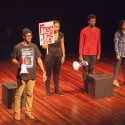Exhibition celebrates the music, art and culture of Ghana
“In Ghana, textiles are absolutely integrated into every part of life,” says Mary Hark. “You’re bombarded with music and textile, color and pattern, while walking down the street.”
In a multi-part exhibition, Hark hopes to bring many of these elements to Madison.
“Look, Look, Listen, Listen: Celebrating the Arts of Ghana” reflects the interconnected culture of west Africa. The exhibition, presented by the University of Wisconsin–Madison Design Gallery, highlights contemporary and traditional artists whose visual and musical creations are influenced by the dynamic cultural activity and street life of the Greater Ashanti Region.
“The whole event allows the viewer to consider artistic production closer to the way it’s experienced in Ghana. Nothing is experienced in isolation,” says Hark, assistant professor of design studies in the School of Human Ecology. “This event encourages you to think about textiles in context: with the music, with contemporary expression that is deeply informed by the music, with the environment. It’s all bound up together.”
In many ways, the event started as a book launch.
The project began in 2006 when Hark traveled to Ghana on a Fulbright research grant. When she sought out printmaking peers at the university in Kumasi, she met internationally known painter Atta Kwami and his spouse, British-born printmaker Pamela Clarkson. Splitting their time between Ghana and the United Kingdom, both artists represent the realities of an “African world” in which people and ideas move seamlessly between cultures.
“Pamela is not part of the African diaspora, but she’s definitely African in some sense,” says Hark. “It’s a wonderful acknowledgement of working between cultures: carrying your own history while creating work in response to a place. It’s such an important part of our current world.”
The three formed Take Time Press, a bridge between fine art and local culture, using materials found exclusively in Kumasi. Their first publication, a limited edition art book, is now on display in the Kohler Art Library (through December).
“Listen Listen: Adadam Agofomma” honors the work of Koo Nimo, an elder statesman of West African music recognized by the government of Ghana as a National Living Treasure. Performing the gentle melodies of traditional palm wine music, Koo Nimo and his ensemble translate stories and songs from Ashanti culture into a language global audiences can understand.
“Our mission statement celebrates the local culture and creates a platform for international collaboration,” says Hark. “The book as an art form is new to that area. We wanted to make this book with the highest of standards to show what was possible.”
The book (printed by Clarkson and Hark) showcases Hark’s handmade paper, fine art prints from Atta Kwami and a CD and digital slide show of Koo Nimo’s music. “Listen, Listen” is the first of a planned triptych celebrating the interconnected culture of the region; later volumes will focus on the physical environment and the textiles. Copies of the book have found homes at the Metropolitan Museum of Art and the Smithsonian Institution.
A two-sided exhibit in Madison’s Common Wealth Gallery, 100 S. Baldwin St. (third floor), showcases work that went into the book — and inspired it. The exhibit is on display through Sunday, Dec. 4 from noon–6 p.m.; a public reception takes place on Friday, Dec. 2 from 5–8 p.m.
On one side, “Place to Place” showcases recent works by Kwami and Clarkson, both master artists. Their experiences living on two continents express the interplay between cultures: traditional and contemporary, African and European.
On the other side of the gallery, traditional textiles complement the bright colors of the more formal art. In “Tradition and Innovation,” hundreds of yards of batik fabric by Dorothy Amenuke share space with Adinkra cloth from the Boakye Family Workshop. Adinkra, a type of stamped cloth traditionally worn in mourning, incorporates symbols that visualize and comment on many aspects of human behavior. The living tradition continues today, as contemporary symbols join historic designs on nearly any printable surface.
The exhibition culminates with a free concert by Koo Nimo himself. During a week-long residency, Koo Nimo performs with Madison’s Atimevu Drum and Dance Ensemble on Sunday Dec. 4 at 3 p.m. in Music Hall, 925 Bascom Mall.
Though this main exhibition ends soon, Hark and her collaborators are energized to continue. With support from Ghanaian and American sources, they hope to establish a permanent workshop in Kumasi. It may become a cottage industry for local artisans or a department at the university; it may do both.
Either way, Hark is excited to see what comes next.
“It’s been a wonderful articulation of the Wisconsin Idea, in a global format,” says Hark. “It’s also an example of how you can enter the world through many portals, many small, obscure doors: papermaking, textiles and book arts. Out of that, the potential is unlimited.”
Subscribe to Wisconsin Ideas
Want more stories of the Wisconsin Idea in action? Sign-up for our monthly e-newsletter highlighting how Badgers are taking their education and research beyond the boundaries of the classroom to improve lives.


